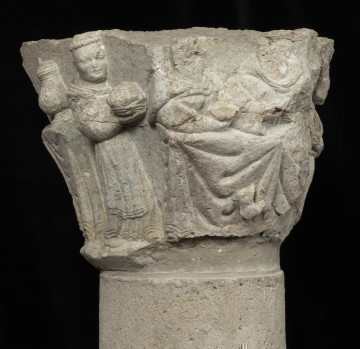
Capitol depicting meal of monks
1330 — 1340
National Museum in Szczecin
Part of the collection: Romanesque and early gothic stone capitals
In the tradition of Western Christianity, a monastery was considered a symbol of the garden of Eden since the beginning of monastic life. Bernard of Clairvaux, a 12th century theologian and originator of Medieval mysticism, an outstanding Cistercian monk and a saint of the Catholic Church, made willing references to such symbols. In his literary meditations, he called the cross (which was the main element of the interior design of Cistercian churches) the Tree of Life, standing in the centre of the paradise. Such allegory led to the popularity of plant ornamentation in the decoration of initially austere interiors and façades of the typical Cistercian churches. The common grape wine, leafy creepers and various leaves appeared on façade friezes, capitals and decoration of stalls. The presence of oak branches on one of the capitals preserved from the interiors of the Cistercian monastery in Kołbacz forms a part of the palette of the paradisus claustralis iconographic motives. The basic meaning of the oak tree, which is the king of trees, also in non-Christian cultures, was of essence when selecting this motive for the decoration of the capital. The oak symbolises power, perseverance and eternity. These features refer to the power of the Christian faith and eternal life. The motive of the five-leaf branch probably denotes the worship of Christ’s wounds, which was primarily propagated by St. Bernard of Clairvaux. The white monk claimed that the contemplation of the five wounds of Christ was conducive to penitence and an efficient medication cleansing the soul and the heart from sins. It also offered protection from the evil spirit's doings. The decoration positioned in the architectural space of the monastery could have functioned as an admonition to the daily practice of prayer to Christ’s wounds.
Kinga Krasnodębska
Author / creator
Dimensions
cały obiekt: height: 41 cm, width: 53 cm
Object type
capital (architecture)
Creation time / dating
Creation / finding place
Identification number
Location / status

1330 — 1340
National Museum in Szczecin

1330 — 1340
National Museum in Szczecin

1330 — 1340
National Museum in Szczecin
DISCOVER this TOPIC
National Museum in Szczecin
DISCOVER this PATH
Educational path